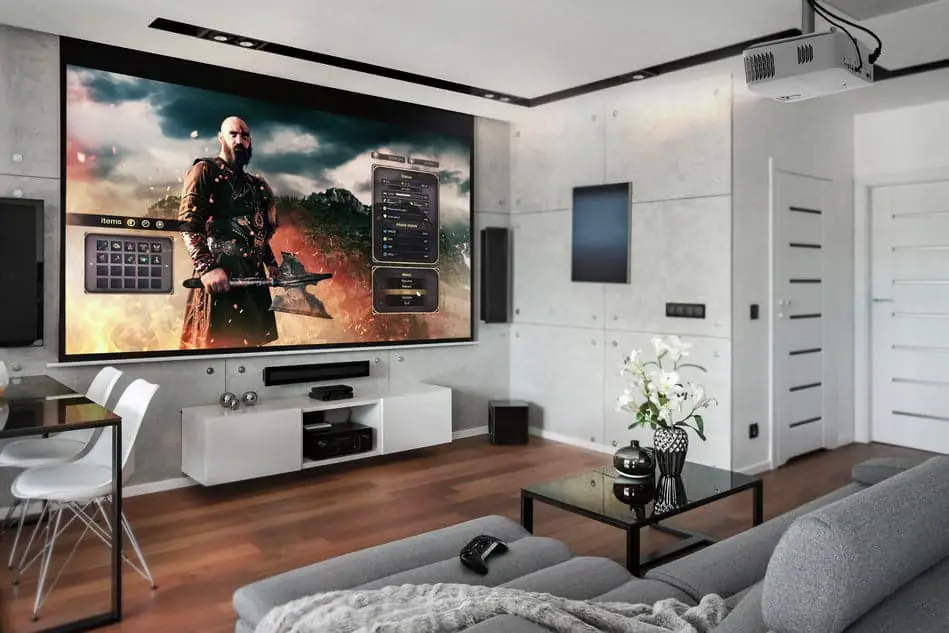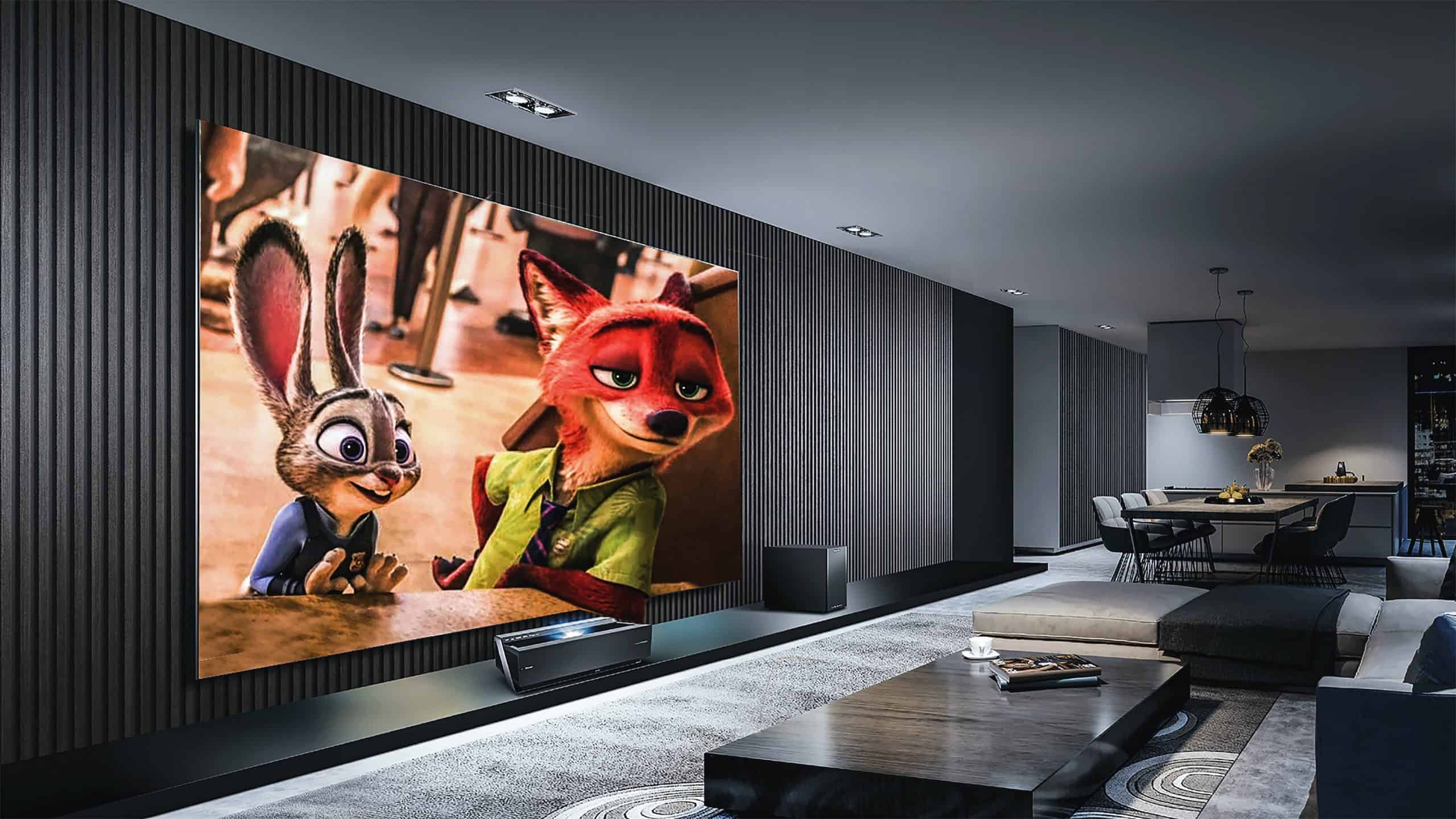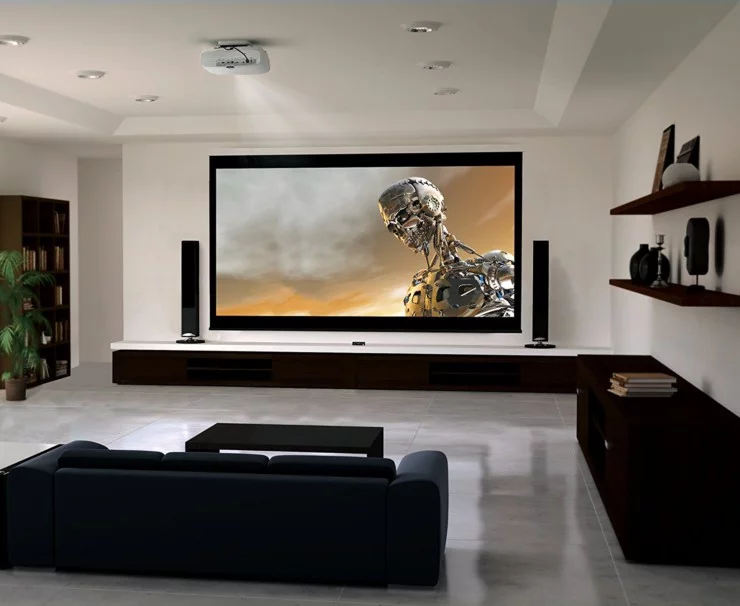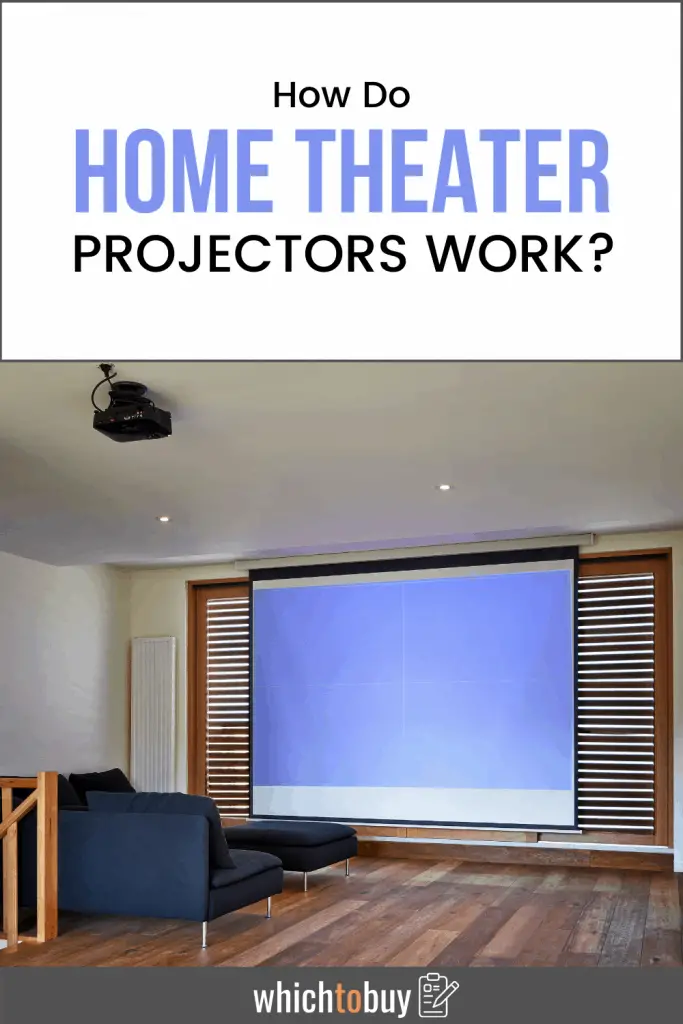Until recently, the best movie experience would be going to the cinema. But, the technology has evolved so much that now you can turn your living room into you’re a home theater. To do so, you will need to have a screen (or an empty wall), at least four speakers, and a projector. But, how do home theater projectors work? Keep reading to find out!
Table of Contents
How Do Home Theater Projectors Work?
Before we get to the part where we explain how does a home theater projector work, we will have to teach you some basics. First of all, it is important to know that you can find three types of home theater projectors on shelves.
The first type is LCD (liquid crystal display) projectors. These projectors use polarized light which shines through three liquid crystal panels (one for each primary color), as well as a prism, a lamp, and a filter to create your image, which then is “projected” (hence the name), through the lens.
When it comes to the panels, the first one displays the image which is split into primary colors. The image passes through the second LCD panel that recombines the colors by separating the light depending on what you want to be reflected and what’s allowed to get through. Each panel shines a different color (red, green, or blue) and sends the color through the final LCD panel.
The second type of home theater projectors is called DLP or Digital Light Processing projector. These projectors rely on a DMD chip. Each chip contains millions of tiny little mirrors and each mirror is smaller than 1/5th of a human hair across. A rapidly spinning color wheel shines a light that reaches the DMD chips. Then, the chips use the mosaic effect to display one color on each mirror. Every mirror stands for one pixel and, for example, in a 1920×1080 projector there are over 2 million mirrors. If you looked at them up close, you wouldn’t see anything. But, when viewed from afar, the pixels create a complete picture of what you’re supposed to be looking at.
The newest type of projectors is called LCoS, which stands for Liquid Crystal on Silicon. This is the most complex, most advanced, and most expensive type of projectors. As a matter of fact, explaining how these projector works would take up an entire article, but we’ll try to sum it up in three brief points.
- LCoS is a hybrid between DLP DMD and 3-chip LCD technology
- These projectors have far superior color reproduction and clarity than other home projectors..
- LCoS can suffer from motion blur issues whereas DLP is unlikely to.
Regardless of the way that the image is created inside of the projector, all three types push light through the lens to create a large picture on your screen or wall. Each projector has its “throw” distance and they can be separated into three categories: long throw, short throw, and extra short-throw.
The majority of projectors feature a long-throw lens, which creates a narrower depth of field in its image and it is also smaller. Translated into English, this means that you can use these projectors to create larger images but there needs to be plenty of available distance between the projector and the screen or wall.
Short-throw lenses are larger and function similarly to long-throw ones. However, they can replicate the same-size image placed half the distance as the long throw projectors.
Ultra short-throw projectors are the most expensive type and they can create images as large as 100” from less than a foot and a half away from the screen or wall. If you live in a small-sized apartment and you have some extra money to spare (these projectors usually cost more than £1,000), then you should go for ultra-short-throw projectors. Otherwise, a regular short-throw will work just fine for you.
Basics of Home Theater Projectors
The latest home theater projectors are sleek, professional, high-quality, and affordable. They even cost less than many HD televisions and they have many advantages including the fact that the size of the image is determined by the size of your room.
Now that you have a basic understanding of how do home theater projectors work, here are three additional factors that you should consider when choosing the right projector for your needs.

-
Resolution
Just like TVs, home theaters also come in various resolutions. There are only two resolution options available – 720p and 1080p – and both are considered high-definition. What do these numbers stand for? The simplest explanation would be that 720 and 1080 represent the number of pixels that fit the screen from top to bottom.
The difference between 720p and 1080p is minimal and most people don’t notice it. So, if you have a limited budget, you can get yourself a 720p projector (the more affordable option) without worrying that you’ll miss out on something.
-
Brightness
As we mentioned above, each projector has a brightness which determines whether it can be placed in a dark room only. Every home projector has a bulb and, the brighter the bulb the larger the picture and the better the visibility despite the ambient light.
If you have a dark room (such as a basement) that you can transform into your home theater, then you don’t have to worry about the brightness and you can choose a less expensive model. However, if you plan to place the projector in a room with some ambient light, then you’ll want to get a projector with a brightness rating higher than 2,000 lumens.
Unfortunately, the more lumens a projector has, the more expensive it will be.
-
Zoom Range
Depending on the spot you plan to mount your projector and how large your screen is, you will need to make sure that your projector’s lens will throw a large enough picture onto your screen. If you place the projector too close to the screen, you won’t be able to zoom out and create the ideal picture size.
So, before you get a home theater projector, you need to decide where you’re going to mount it and how big of a screen you prefer. But, we’ll discuss this in a bit!
What to Consider Before Buying a Home Theater Projector?
Now that you know how do home theater projectors work, it is time to discuss should you buy one. Using projectors tends to be a bit more complex than using TVs and requires a little extra consideration.
If you don’t want to spend too much money and you already have a decently-sized TV, you can simply invest in a good stereo system. For example, a basic surround system and a brand new DVD player could cost you around £500. But, if you plan to get a new TV as well, then be prepared to invest several thousand dollars.
But, if you really want to bring your home theater to life, then getting a projector is the way to go. However, make sure to read the following factors that will help you determine whether you are ready for buying a projector or not.
Image Courtesy of 4k.com
-
The Light in the Room
The first thing you should pay attention to is the lighting in the room where you plan to put the theater in. Some years ago, projector brightness used to be an issue, and projectors had to be placed in very dark rooms. But, nowadays, home projectors can handle some light. It’s much easier to find a model that can handle moderate light or even well-lit rooms.
However, the old rule still applies – the darker the room, the better the picture quality. Projectors need darkness because of contrast and so that the image wouldn’t look washed out. Darkness also improves color calibration. People tend to choose basements for their home theaters because they tend to be dark by nature. However, you can also place the projector in a room with windows as long as you can block out that light with curtains or shades. If you can put curtains or shades, then any room in your home will work for a home theater.
-
Is There Enough Space
Not only are you going to need the space to install a screen but also the means. There are several ways you can accomplish this. First of all, you can get a manual or motorized drop-down screen and mount it from your ceiling. Or, you could try mounting a fixed screen to a wall, if there is enough space. There are even special projection-screen paints for walls that will make the screen blend in with the wall seamlessly.
Keep in mind that the screen is not the only thing you’re going to install. You will also need speakers, an A/V receiver, and some furniture unless you plan to sit on the floor. To make sure that everything fits in perfectly, you can use online calculators that will give you precise width and height measurements for any given 16:9 screen size.
-
Don’t Forget About the Distance
When we explained how do home theater projectors work, we pointed out the importance of placing the projector on the right distance. And, there are two distance points you should think of before getting a projector: the throw distance (the distance between the projector and the screen) and viewing distance (how far is the screen from your seat).
We mentioned the benefits of short-throw projectors, the ones that can be placed a few feet away from the screen, and provide a 100-inch diagonal widescreen image. The ultra-short-throw projectors can achieve the same image from as little as 4-5 inches away, but, they tend to be more expensive. The best way to determine if you have enough space for the projector type you’re considering is by using an online throw-distance calculator.
When it comes to the viewing distance, there are also several online calculators that tell you how far from an image you should sit. But, to make this easier for you, we’ll share a tip from the experts; they recommend that you sit 10 feet from a 110-inch screen.
-
Do You Have the Right Spot for Installation?
The previous three tips focused on the factors that mostly affect the screen and the image projection. But, don’t forget to give the projector some consideration as well. If you can’t place the projector at the recommended distance and angle from the screen, then it is not worth the buy.
Ideally, the center of the projector’s lens should align with the horizontal center of your screen, although some projectors do allow for offset installation. If you are unable to place the projector in the dead center, then you should consider getting a projector with a lens-shift feature. This will allow you to make some adjustments and still be able to get the perfect-quality image on the screen. Even though this feature comes in handy, remember that the best image quality comes from a centered projector.
Oh, and don’t forget about the cables! You should make sure that you can run at least one HDMI cable as well as the power to the installation location. This is much easier if you plan to get a projector and place it in a cabinet or on a table. If you plan to get an in-ceiling projector, then you’ll need to run wires along the inside or the outside of the wall and ceiling.
Don’t forget that you will need to get a projector mount, whether you plan to mount the projector on a coffee table, a piece of furniture, or the ceiling. These usually cost around £100.
In general, installing a projector is not as complicated as it may seem to you right now. To ensure that we’re telling the truth, check out this simple home projector installation guide!
-
You Will Need an A/V Receiver
Every good home theater should have a quality A/V receiver. Projectors come with fewer connection ports than TVs do, so an A/V receiver is a natural fit for projector setups. If you plan to connect only one source device to your projector, such as a streaming device, game console, or Blu-ray player, then you won’t need any additional equipment.
Most projectors have only one HDMI input, and if you have multiple devices then investing in an A/V receiver is a must. An alternative would be getting an HDMI switcher. But, the only reason why you should get an A/V receiver is that it will provide high-quality sound and allow you to set up a full surround sound system or, at least some decent stereo speakers.
Getting a home theater projector is not an ideal choice for everyone. You need to set aside enough space for the projector and the screen and place them in a room that has low ambient light. But, if you do meet these requirements, then getting a home projector is a must! It will give you a completely different entertainment experience from watching a TV, no matter its size.
If you’re wondering how much home theater projectors cost, we have some great news for you. They are really affordable! Make sure to check out our list of the best projectors under £200.
Our guide was meant to demonstrate how do home theater projectors work and to help you decide whether a projector is a right choice for you. We hope that you carefully read all our tips and that now, you’re on your way to set up a perfect home theater for your needs that will have your friends and neighbors knocking down your door.



